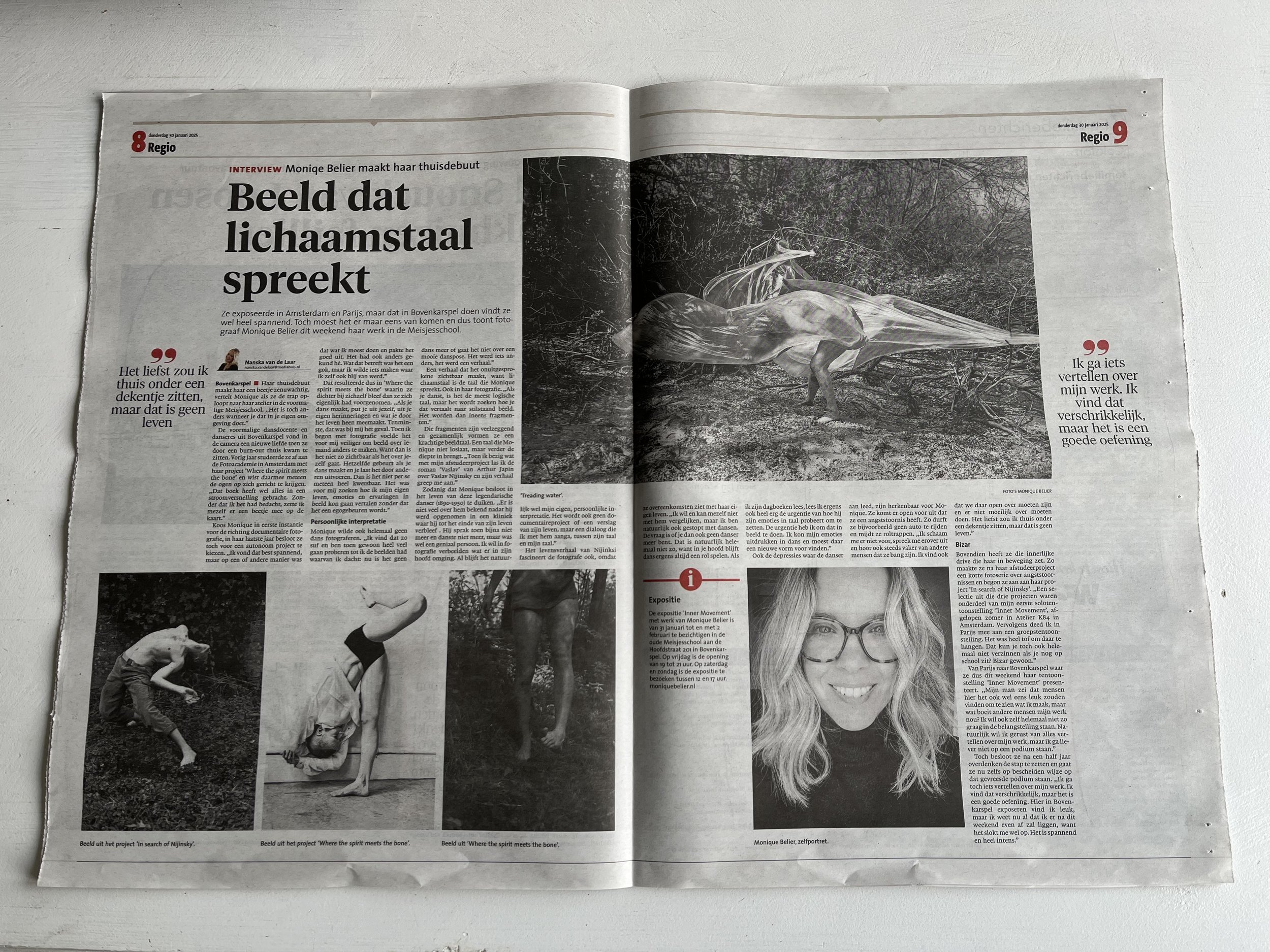Interview Noord Hollands Dagblad
An interview in the Dutch Newspaper Het Noord Hollands Dagblad by Nanska van de Laar, about my work and exhibition Inner Movement.
(English translation below)
Interview: Monique Belier Makes Her Home Debut
Images That Speak Body Language
She has exhibited in Amsterdam and Paris, but doing so in Bovenkarspel feels particularly nerve-wracking. Still, it was time to take the plunge, so photographer Monique Belier is showcasing her work this weekend at the Meisjesschool.
Bovenkarspel
Her home debut makes her a bit nervous, Monique admits as she walks up the stairs to her studio in the former Meisjesschool. “It’s different when you do this in your own environment.”
The former dance instructor and dancer from Bovenkarspel found a new love through the camera, and after experiencing burnout, she discovered a new focus. Last year, she graduated from the Photo Academy in Amsterdam with her project *Where the Spirit Meets the Bone*, which immediately drew attention.
“That book really set everything in motion. Without planning it, I kind of put myself on the map.”
Personal Interpretation
Monique never intended to photograph dance. “I find that a bit dull, so I just started experimenting a lot until I created images that no longer felt like dance or just a beautiful pose. It became something else—it became a story.”
A story that makes the unspoken visible, as body language is Monique’s native tongue. That same language translates into her photography. “When you dance, it’s the most natural language, but figuring out how to convey that in still images is a challenge. Suddenly, they become fragments.”
Those fragments are expressive, and together, they form a powerful visual language—one Monique continues to explore in greater depth. “While working on my graduation project, I read *Vaslav* by Arthur Japin, about Vaslav Nijinsky, and his story deeply moved me.”
Nijinsky
So much so that Monique decided to delve into the life of this legendary dancer (1890–1950). “There isn’t much known about him after he was admitted to a clinic, where he remained for the rest of his life. He hardly spoke and no longer danced, yet he was a genius. I want to visualize what was going on inside his mind. Of course, it’s still my own personal interpretation. It won’t be a documentary or a factual account of his life, but rather a dialogue between his language and mine.”
She sees parallels with her own life. “I don’t want to compare myself to him, but I also stopped dancing. The question is: does that mean you’re no longer a dancer? Of course not—dance continues to play a role in your mind.”
“When I read his diaries, I strongly feel the urgency with which he tried to translate his emotions into language. I feel that same urgency to express mine through images. I used to communicate through dance, and I had to find a new way to do that.”
Nijinsky’s struggles with depression also resonate with Monique. She openly shares that she has an anxiety disorder—she doesn’t drive and avoids escalators. “I’m not ashamed of it. I talk about it, and I hear more and more people admitting their fears. I believe we should be open about these things and not make a big deal out of them. Honestly, I’d rather stay at home under a blanket, but that’s not a life.”
From Paris to Bovenkarspel
Despite these challenges, she has an inner drive that keeps her moving. After her graduation project, she created a short photo series about anxiety disorders and then started *In Search of Nijinsky*. “A selection from these three projects was featured in my first solo exhibition, *Inner Movement*, last summer at Atelier K84 in Amsterdam. I then participated in a group exhibition in Paris. It was incredible to see my work displayed there. You can’t even imagine that while you’re still in school—just surreal.”
From Paris to Bovenkarspel, where this weekend she presents *Inner Movement*. “My husband suggested that people here might also enjoy seeing my work, but I thought, ‘Why would anyone care about my art?’ I don’t even like being in the spotlight. I’m happy to talk about my work, but you won’t catch me standing on a stage.”
Yet, after six months of contemplation, she decided to take the step—and now, in her own modest way, she will stand on that dreaded stage. “I’ll say something about my work. I hate it, but it’s good practice. Exhibiting here in Bovenkarspel is exciting, but I already know that after this weekend, I’ll need time to recover. It’s intense and overwhelming.”


